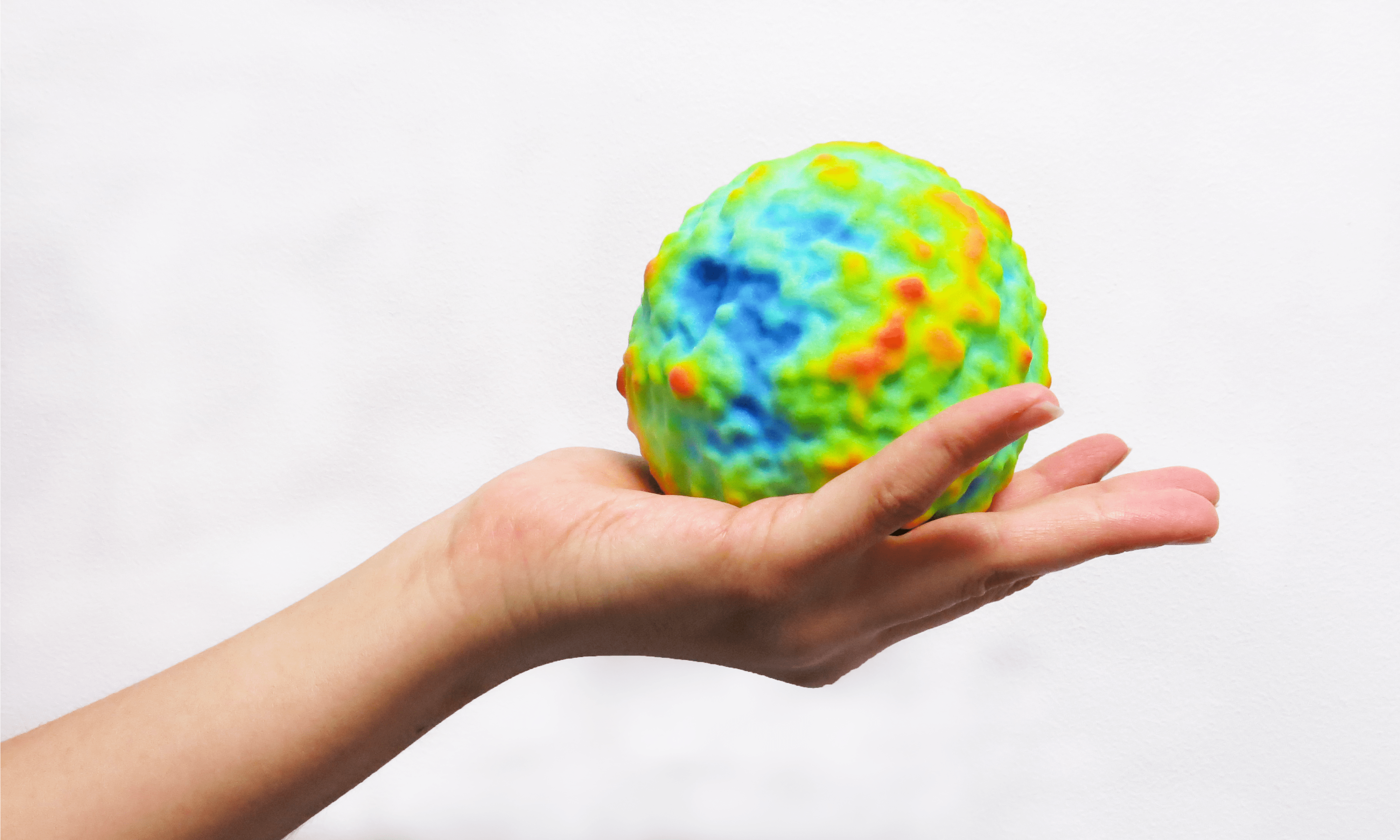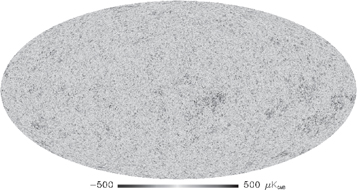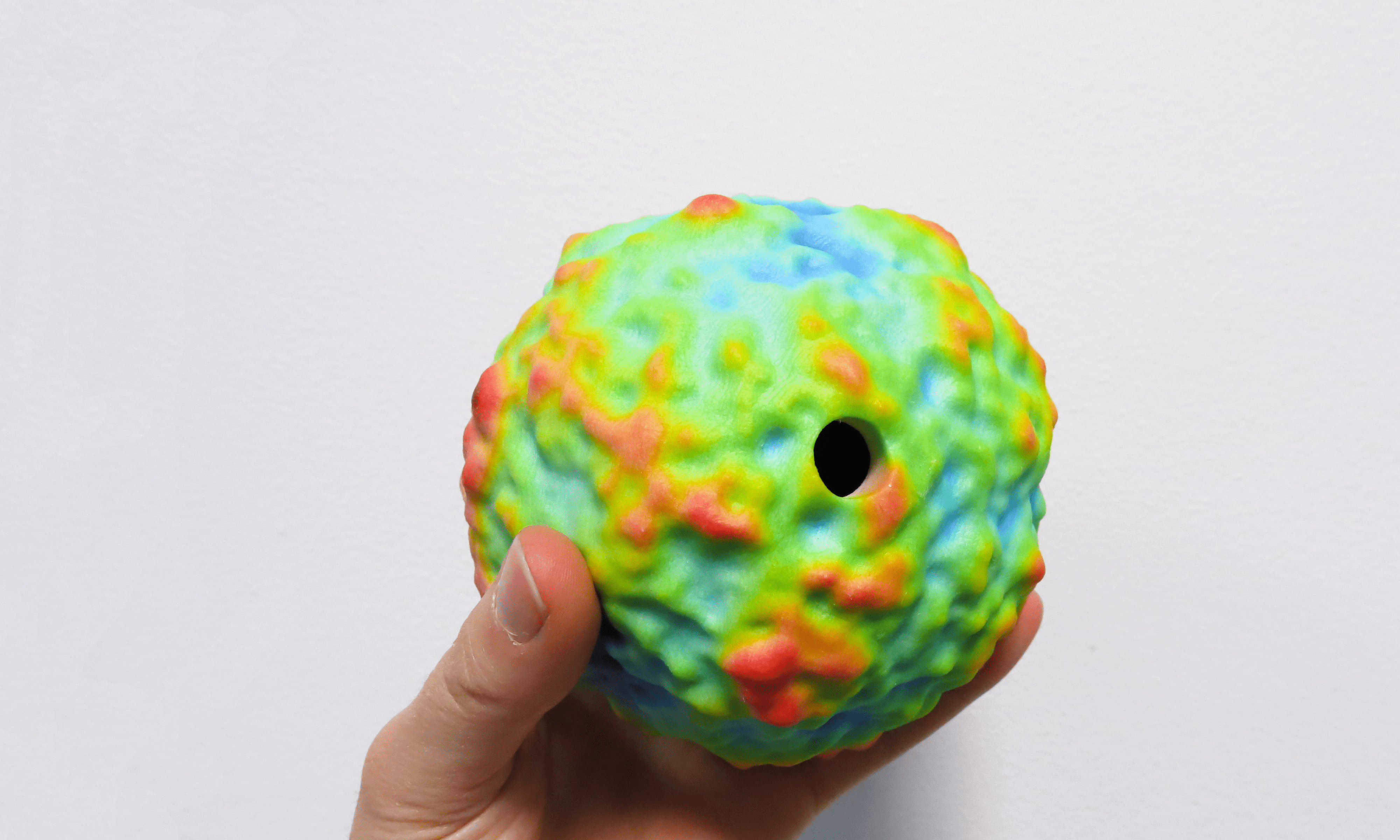How We 3D Printed the Universe
Posted By Eole Recrosio on Nov 9, 2016 | 0 comments
“We are an impossibility in an impossible universe.”
Ray Bradbury.
Scientists recently built a way for everyone to hold this impossible universe in the palm of their hand with a 3D printed model! And there’s more: they made the 3D file of the universe available for all, and we 3D printed it! How was this representation achieved? How can you have the universe at home?
How does one take a picture of the Universe?
The first “picture” of our universe dates from 1992 and displayed the thermal marks (temperature fluctuation in the plasma background of our universe) left by the Big Bang about 13 billion years ago. From this first representation to the last one in 2014 by the Planck mission, the range of what we are able to view considerably raised. The thermal marks called Cosmic Microwave Background (CMB) were left by the Big Bang and can be related to the density of matter in the universe. They were frozen in the radiation background, which is why it is still observable today. The data, gathered by the scientists team from the Imperial College of London are estimated to date back from around 320 000 after the Big Bang which is, for now, the first record we have of the universe.
From old representations to 3D printing
The scientists team gathered the data and thought about a new way to represent it. Traditionally, the CMB temperatures are visualised on complex graphs and often transferred onto a colour table from blue for the cold to red for the hotter temperatures recorded into the CMB. For cosmologists and experts, this representation is understandable but for the ordinary mortals we are, it is quite obscure! Dr Dave Clements and his team decided to create that easy-to-understand map by establishing a flat blueprint of the CMB map of the universe. As for the earth, we usually and for practical reasons show the earth with a flat representation even if it a floating sphere in a huge space. That huge space – the universe – surrounds us and is by the same process flatten for the scientist to easily represent it.
Then, Dr Clements had a great idea: he and his team turned the flat representation of the universe into a touchable sphere.
A free file for everybody
From the blueprint, they used several steps of 3D design (HEALPix, MeshLab, NetFabb, Blender…) to finally obtain two usable 3D files: an STL file for Ultimaker printing (monochromatic) and a VRML file for the Zcorp printer (coloured). The sphere map precision is not the same as the flat one because of the constraints of size and readability.
It is available for order on our website here
In full size (10 cm of diameter), the ball is a bit pricy but you can reduce the size by 70% (7 cm of diameter) and you’ll get the colored version of the universe for $60 only!
You can find the original 3D printing file on this website in coloured and monochromatic version and also print it by yourself.
Even the universe is cheaper with the hollowing tool!
You can also notice the presence of a small hole (1 cm) used for the hollowing process. It allows the excess material to be drained off the sphere and by the way, it reduces the weight and the price of the 3D printing. We write about this to remind you to include such a hole in your next designs, to allow the powder to be evacuated, and your object to be hollowed. For this model is already hollowed, you don’t have to take care about it.
3D Printing to enable science and education: understanding the mysteries of the universe!
The purpose of the project, initiated by Dr. Dave Clements of the Imperial College of London, is to allow a better understanding of the biggest mysteries of the universe at an open scale. Where do we come from ? What is the famous “Cold Spot” of the universe ? The 3D printed version is a new approach for anyone to read and understand how is composed our universe.
The sphere is still precise: the bumps show the heat spots and the dips the cold ones. When you close your eyes for a second and let your fingers walk on the surface, you can feel the complexity of the detailed map.
The monochrome version allows to feel this waved surface but the one colored paints the different spots. From cold blue to red, the bumps are revealing a fascinating map of what was our universe at its first steps.
The other motive to design a 3D printed version is to bring a physical material for teachers. With an object like this sphere, pupils would be able to touch and turn it around to easily have an idea of what constitute our universe.
We can also think to visually impaired and blind people, especially sensitive to this kind of projects. The tactile approach is ideal to feel the complexity of the universe thanks to the 3D printing model accuracy.
Thanks to 3D printing, the team has succeeded in getting a new material for all the astrological lovers from scientists to teachers. Once again, this technique harbour the hope of developing projects like that in education and science.
Learn more about 3D printing and education with our free ebooks
What about you ? Will you print your own tiny universe ? If you already does, share a picture of it on Facebook, Twitter or Instagram


 Connect with Google
Connect with Google Connect with Facebook
Connect with Facebook

